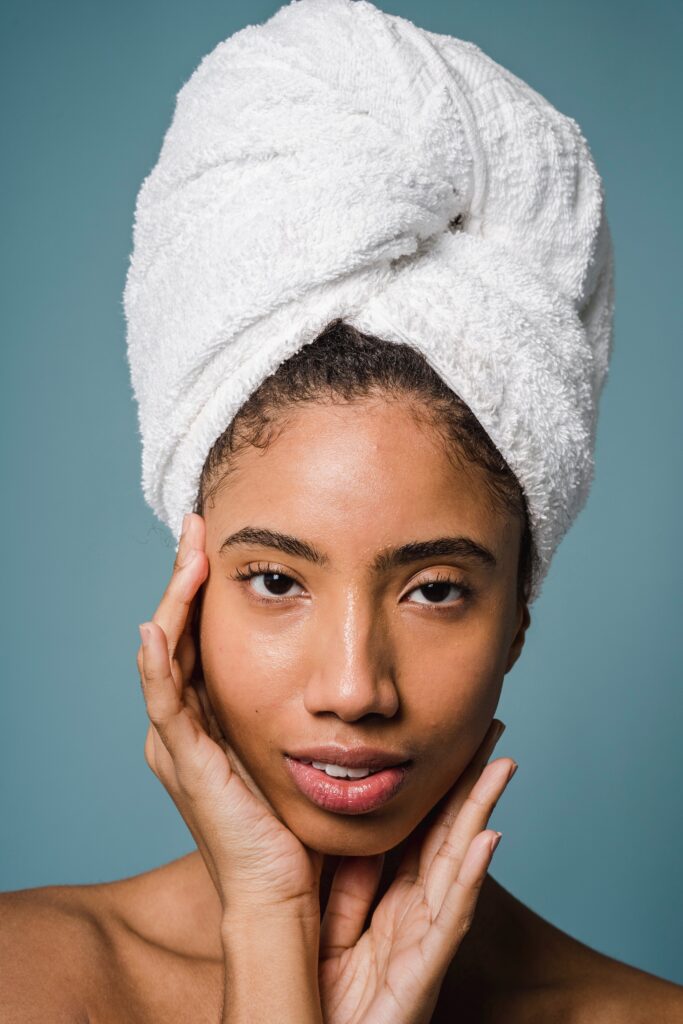
My hyperpigmentation journey goes as far back as nearly 20 years ago when I was about 13 years old. I remember the first time noticing hyperpigmentation above my upper lip. No one else seemed to notice it (or they wanted to spare my feelings) but I did, and it bothered me. My skin just didn’t look clear with the uneven skin tones. It was something, even if you couldn’t put your finger on it, that just looked “off” to the naked eye. I immediately took steps to addressing the issue which brought me to my toxic (literally) relationship with hydroquinone that has somewhat continued up until now. In this article we’ll address what causes that stubborn “sun-stache”, what makes hydroquinone effective but unsafe, some mistakes I made on the way, and the thorough steps I’ve taken to stabilize the discoloration.
What Causes Hyperpigmentation And How To Treat It?
Hyperpigmentation (or hyperactivity of melanin) tends to be caused significantly by hormonal influences, inflammation or through overexposure of the sun.1 Melanin is the pigment that gives color to our skin, hair and eyes. There are two types of melanin: eumelanin and pheomelanin. Eumelanin creates the darker pigment in darker skin tones, those with lighter skin tones have reduced levels of eumelanin. It absorbs the UV rays from the sun, and helps to regulate the body temperature by keeping the body cool. Those with high levels of eumelanin are at less risk of getting skin cancer than those with lower levels. Pheomelanin causes lighter pigmentation so those with lighter skin tones have more of this while those with darker skin tones have reduced levels. The color resembles a yellow-red tint. Pheomelanin does not absorb UV rays as efficiently as eumelanin so those with higher levels have higher risk of sunburn or sun related damage to the skin. Pheomelanin though can also protect the skin from melanoma and other types of skin cancer. Pheomelanin can reflect heat off of the body to keep it cool in hot conditions.2
Hormones that affect melanin production are the adrenocorticotropic hormone, lipotropin and melanocyte stimulating hormone. Increased use of melatonin can also result in a grayish-brown tint to the skin.2, 3
In my case I am prone to hyperpigmentation specifically on my upper lip and have been ever since I hit puberty so it’s definitely hormonally driven. However, when I go out in the sun the hyperpigmentation skyrockets! The UV rays and free radicals produced by the sun take a part in increasing the pigment in the skin. Melanin is produced in response to the UV rays and free radicals to protect the skin from its potential harm. Free radicals are unstable, oxidized molecules that can cause damage to the DNA of the cells and can cause premature aging.2, 4 Free radicals can cause inflammation to the skin which can also increase melanin production.2
The sun rays was an issue I could readily address. I started, for the first time wearing sunscreen on my face. Unfortunately for me even a little bit of sun could cause the hyperpigmentation to spiral out of control so I had to be religious about the sunscreen use. Although this practice prevented the hyperpigmentation from getting worse, it didn’t reduce it. That’s when I started looking into brightening agents that could correct the dire situation.
Hydroquinone
My solution came in a slender brown tube found in a CVS. It was the Ambi 2% hydroquinone cream also mixed with vitamin E for hydration. It was titled perfectly as the “fading cream” for discoloration. Hydroquinone has its benefits(believe it or not) however it has some serious cons.
Benefits
- Lightening results are typically quicker than using less aggressive brightening agents like vitamin C or turmeric
- The product itself had vitamin E to prevent dryness in the skin after hydroquinone use and the vitamin E helps reduce inflammation.
- The product also contained sunscreen in it as hydroquinone (and many lightening agents except for vitamin C) make you more sensitive to the sun.
Cons
- May be contaminated with mercury (very toxic element that’s also seen to brighten skin)5
- Has been seen to cause malignancies in animal studies with prolonged exposures to hydroquinone with oral doses.6
- Can cause discoloration to the skin if used incorrectly or for prolonged periods
Hydroquinone has recently (within a year) been banned from being sold over the counter5 but, again, my toxic relationship ran so deep with hydroquinone that even knowing some negative side effects wouldn’t deter me. I wasn’t someone who was completely fixated on my appearance growing up, but a change to my norm really through me off and I was convinced that’s all anyone could see because that’s all I could see. I used hydroquinone on my upper lip area so much I got rebound hyperpigmentation. As hydroquinone can cause inflammation to the skin, overuse of hydroquinone could cause post inflammatory hyperpigmentation as a protective measure.2 For me it took nearly a year to fully eradicate the rebound hyperpigmentation. The irritation created a pigmented mustache that wouldn’t go away but all my actions afterwards just made it more angry.
Mistakes & Solutions
I used Murad’s vitamin C with glycolic acid as an effort to stay off the hydroquinone but I ended up finally feeling the burn from the injuries I had been causing to my skin all this time. I literally made my skin raw. The best thing for me to do was give my skin a break (and use concealer!). The break gave my skin the much needed time to heal and lower its shields as I had unknowingly put it in defense mode since I was a teenager. During the HQ hiatus, I did several non ablative laser treatments (also read Clear and Brilliant : My Favorite Laser Resurfacing Treatment) which resurfaced my skin and truly helped with lots of my pigmentation issues. My skin care game also improved and helped with subduing the hyperpigmentation. I was using growth factors and retinol and vitamin C, all things that helped stabilize and improve my skin texture and barrier overtime as well as even skin tone. At this point I’m in my late 20s and although the rebound pigmentation had settled, the issue of being in the sun for 5 mins too long was still causing the sun-stache to come out in full effect. Vitamin C sometimes lightened the area but never quickly and the reduced pigmentation had a hard time lasting. During this time if hyperpigmentation came in, I would spot treat the area with, sadly, hydroquinone until the pigmentation went away in about two weeks. Then I would attempt to wear the sunscreens and vitamin c to continue suppressing the hyperpigmented areas. This ongoing toxic cycle was my way to address the pigment troubles up until a few months ago.
As an aesthetic nurse, I tend to be exposed to and gifted lots of corrective skincare in hopes that we would like it and rave about it to patients. One of these items given to me was the A-luminate Brightening Serum by Alastin. This item has worked for me like no other lightening agent has! Now, in terms of lightening extreme hyperpigmentation it’s a little difficult for me to speak on that as my last extreme sun stach was treated with hydroquinone about 6 months ago. However, I have never been able to go this long (sans sunscreen) with not only my hyperpigmentation not returning, but my upper lip skin looks exceptionally glow-y, radiant and evenly toned. When some bouts of slight hyperpigmentation did arise, it was knocked down swiftly by this serum and a full pigmentation outbreak ceased from happening.
A-Luminate Brightening Serum Ingredients And Benefits
Benefits
- Clinically proven to reduce many forms of hyperpigmentation like brown spots and age spots
- A proprietary ingredient PATH -3 minimizes surface pigmentation and it protects area against reoccurring hyperpigmentation.
- It does not contain HQ or retinol (retinol quickens cell turnover but can cause dryness)
- Non-irrritating
- Contains antioxidants to protect against free radicals
- Can be used in combination with some laser treatments and peels, enhancing results.
- Brightens skin and reduces redness
Key Ingredients
- Squalane: moisturizes and is an antioxidant 7
- PATH-3 technology: minimizes surface pigmentation from reoccurring and protects skin from future damage
- Tranxameic acid: has anti-inflammatory properties, inhibits pigment production and reduces pigment transfer to upper layers of cells 8
- Niacinamide: supports skin barrier, brightens skin 9
- Thermus thermophilus ferment: protects against UV rays and free radicals10
- Milk thistle: has anti-oxidative, anti-inflammatory properties11
- Ashwagandha: can be seen to increase hydration and elasticity in the skin12
- Silver Ear Mushroom: supports naturally occurring hyaluronic acid (HA) levels in skin. Has 400x more hydration than HA.13
Conclusion
My journey to even skin has been years in the making. I’ve reluctantly stuck with hydroquinone even with the knowledge of its negative effects on the body. There was nothing else that so effectively addressed my embarrassing pigment issues, that was also safe for my skin. Until now. Alastin is truly one of my favorite medical grade skin care lines. Side note: their under eye cream is also the only cream that has truly shown results to my under eye puffiness. They are huge on research based ingredients and are extremely innovative when it comes to addressing issues that haven’t been solved. Their ingredients are science-backed and their products show results which, frankly, is hard to do. The A-luminate brightening serum is one of those serums that’s achieving what alot of other brands attempt to achieve. I’m hoping this product will continue to be my saving grace.
Though aesthetics is important, what’s more important is health. I see a functional medicine doctor and would often get my mercury labs taken, curious of my levels, and they were typically 2-3x over the “safe” limit (there’s no safe limit. There should be no mercury in the body but that’s difficult to achieve in today’s world).14 Whether the HQ I had been using on and off for all these years played a role in my high mercury levels, I won’t really know until I cut it out completely and see if my lab levels eventually reduce.(As of October my levels were reduced by half) Although HQ helped me temporarily boost my confidence, I don’t know what health concerns I may have to address in the future because of it. However, I am glad that the U.S is taking a stance to remove something so toxic out of hands of teenagers like I once was who didn’t know any better and was looking for a quick fix. It’s important to not just settle and use toxic chemicals for the sake of convenience. Research is vital when it comes to finding the best routine for our skin, as consistent damage may be irreparable.
Also Read: The 3D MIRACLE: Trying out the Famous “Cold” Fractional Laser
References
Vega-Lopez, Francisco, and Sara Ritchie. “Dermatological problems.” Manson’s Tropical Infectious Diseases, 2014, p. 995, https://doi.org/10.1016/b978-0-7020-5101-2.00069-8.
- AOCD. “Hyperpigmentation – American Osteopathic College of Dermatology … – AOCD.” American Osteopathic College of Dermatology, www.aocd.org/?page=Hyperpigmentation. Accessed 28 Nov. 2023.
↩︎ - Thawabteh, Amin Mahmood, et al. “Skin pigmentation types, causes and treatment—a review.” Molecules, vol. 28, no. 12, 2023, p. 4839, https://doi.org/10.3390/molecules28124839.
↩︎ - Hall PF. The influence of hormones on melanogenesis. Australas J Dermatol. 1969;10:125-39. PMID: 12304881. ↩︎
- Poljšak B, Dahmane R. Free radicals and extrinsic skin aging. Dermatol Res Pract. 2012;2012:135206. doi: 10.1155/2012/135206. Epub 2012 Feb 29. PMID: 22505880; PMCID: PMC3299230. ↩︎
- Commissioner, Office of the. “Skin Product Safety.” U.S. Food and Drug Administration, FDA, 27 Oct. 2022, www.fda.gov/consumers/skin-facts-what-you-need-know-about-skin-lightening-products/skin-product-safety#:~:text=Skin%20lightening%20products%20containing%20the,care%20provider%20about%20treatment%20options.
↩︎ - Kooyers TJ, Westerhof W. Toxicologische aspecten en gezondheidsrisico’s van hydrochinon in huidbleekformuleringen [Toxicological aspects and health risks associated with hydroquinone in skin bleaching formula]. Ned Tijdschr Geneeskd. 2004 Apr 17;148(16):768-71. Dutch. PMID: 15129564. ↩︎
- Huang, Zih-Rou et al. “Biological and pharmacological activities of squalene and related compounds: potential uses in cosmetic dermatology.” Molecules (Basel, Switzerland) vol. 14,1 540-54. 23 Jan. 2009, doi:10.3390/molecules14010540 ↩︎
- Maeda K. Mechanism of Action of Topical Tranexamic Acid in the Treatment of Melasma and Sun-Induced Skin Hyperpigmentation. Cosmetics. 2022; 9(5):108. https://doi.org/10.3390/cosmetics9050108 ↩︎
- Gehring W. Nicotinic acid/niacinamide and the skin. J Cosmet Dermatol. 2004 Apr;3(2):88-93. doi: 10.1111/j.1473-2130.2004.00115.x. PMID: 17147561. ↩︎
- Souak, Djouhar et al. “Challenging Cosmetic Innovation: The Skin Microbiota and Probiotics Protect the Skin from UV-Induced Damage.” Microorganisms vol. 9,5 936. 27 Apr. 2021, doi:10.3390/microorganisms9050936 ↩︎
- Vostálová, Jitka et al. “Skin Protective Activity of Silymarin and its Flavonolignans.” Molecules (Basel, Switzerland) vol. 24,6 1022. 14 Mar. 2019, doi:10.3390/molecules24061022 ↩︎
- Narra, Keerthi et al. “A Study of Efficacy and Safety of Ashwagandha (Withania somnifera) Lotion on Facial Skin in Photoaged Healthy Adults.” Cureus vol. 15,3 e36168. 15 Mar. 2023, doi:10.7759/cureus.36168 ↩︎
- Collaborator, Power Digital. “Silver Mushroom Benefits for Skin Care.” ALASTIN Skincare, ALASTIN Skincare, 13 Jan. 2021, alastin.com/blogs/intheglow/silver-mushroom-benefits-for-skin-care.
↩︎ - Park, Jung-Duck, and Wei Zheng. “Human exposure and health effects of inorganic and elemental mercury.” Journal of preventive medicine and public health = Yebang Uihakhoe chi vol. 45,6 (2012): 344-52. doi:10.3961/jpmph.2012.45.6.344 ↩︎








You must be logged in to post a comment.